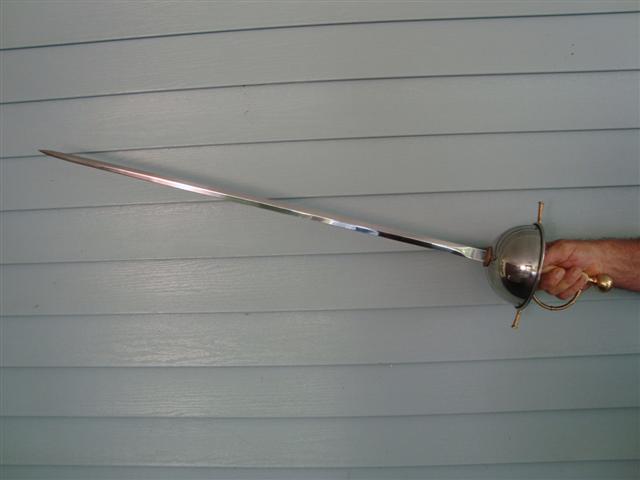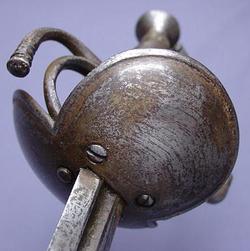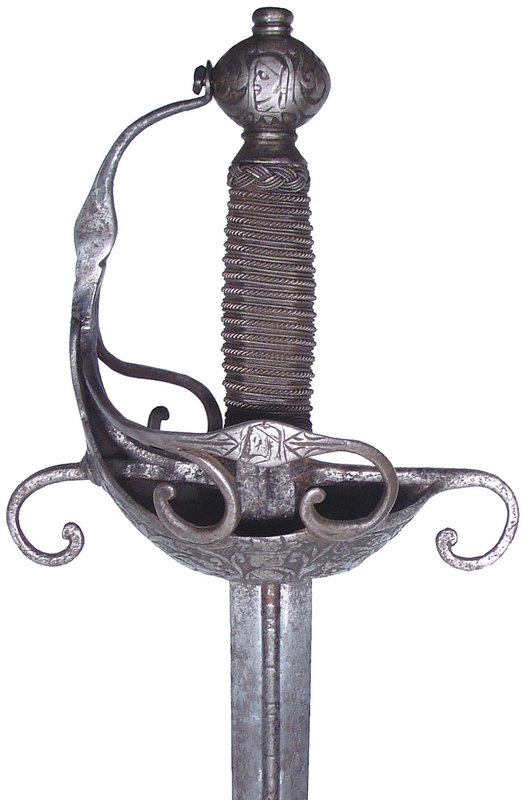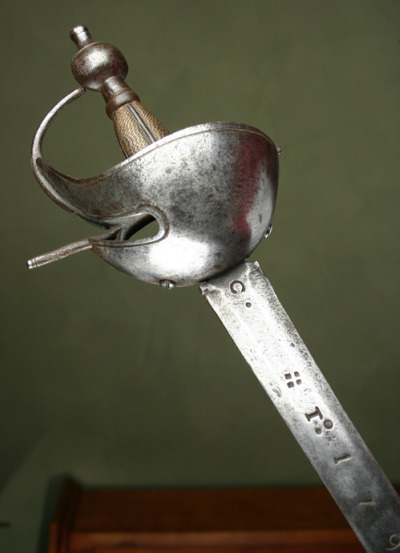
I was looking at the Windlass steel Spanish Bilbo and would like to know if anybody has seen any other examples of this style of sword that I can compare it to.
 Attachment: 91.38 KB
Attachment: 91.38 KB


A topic was just recently posted about this that might help you slightly:
http://www.myArmoury.com/talk/viewtopic.php?t=17808
Here is an attractive version of this type of sword:
http://www.historicalarmsandarmor.com/european_0008.html
Also look at this gallery:
http://www.historicalarmsandarmor.com/Barcelona.html
 Attachment: 180.63 KB
Attachment: 180.63 KB
Spanish Bilbo Sword dated 1796 - Carlos IV
Nice example of a military Spanish bilbo during the reign of King Carlos IV of spain. W [ Download ]
http://www.myArmoury.com/talk/viewtopic.php?t=17808
Here is an attractive version of this type of sword:
http://www.historicalarmsandarmor.com/european_0008.html
Also look at this gallery:
http://www.historicalarmsandarmor.com/Barcelona.html
Spanish Bilbo Sword dated 1796 - Carlos IV
Nice example of a military Spanish bilbo during the reign of King Carlos IV of spain. W [ Download ]
Michael D Long has a bilbo for sale right now. A 1783. Just $4500.00.
For us poorer collectors the Windlass looks to be a middlin recreation which is probably much more agile than the heavy bladed 36 inch broadsword on the original. Don't think it's shipped yet. Therion is advertising it. Kult of Athena advised me it wasn't available yet. I also have a desire to posess one. :D
For us poorer collectors the Windlass looks to be a middlin recreation which is probably much more agile than the heavy bladed 36 inch broadsword on the original. Don't think it's shipped yet. Therion is advertising it. Kult of Athena advised me it wasn't available yet. I also have a desire to posess one. :D
Does anyone know if the swords linked below are properly termed "bilbos" in either Spanish or English, or if that term is only appropriate to hilts with cups intergal and continuous with a knucklebow (as in the MRL example)?
http://ForensicFashion.com/1621SpanishNobleSword.html
Without having made a serious inquiry, I'm under the initial impression that the integral cup-knucklebow form is a later, 18thc. feature, but would like some clarification.
Thanks friends,
r
http://ForensicFashion.com/1621SpanishNobleSword.html
Without having made a serious inquiry, I'm under the initial impression that the integral cup-knucklebow form is a later, 18thc. feature, but would like some clarification.
Thanks friends,
r
Zen Warrior Armory has some good examples double shells (Bilbos) and cup hilts, supposed to be historic . Though EJay has spoken of them and shown some examples elsewhere. I have found I like full shelled guards (bell, cups and shells) over complex guards with bars.The sail guard and bar system of the Sinclair type is appealing, not sure it would work on cvut and thurst though. I have a bell guarded backsword blade and bell guarded saber blade, 1 cuphilt, on a blade that is not really rapier or small sword, but a very well made flattened diamond double edge and very pointy. One more of these blades is destined for a bell guard I woulkd ike to see a bell guard in ther shape of a Schivona with small piercings. The very impressive 1783 Spanish Cavalry sword is only 2250 at Long's now, Doesn't mention Bilbo though.
Last edited by Joe Pittman on Sun 28 Feb, 2010 11:33 am; edited 2 times in total
The attached picture (center) shows a ca.1800 Spanish-Mexican hilt in the Texas State Historical Museum, which labels it a "semi-dragoon broad sword." Its cup doesn't extend into a knucklebow, so I don't if 'bilbo' is appropriate to describe it.
It looks more similar to the MRL "bilbo" than to the 16thc examples from above,
It looks more similar to the MRL "bilbo" than to the 16thc examples from above,
Wiki source says a Bilbo is a cut and thrust from the famous sword works of Bilbo Spain in the Basque region. No Pic. My cuphilt
 Attachment: 26.84 KB
Attachment: 26.84 KB


Last edited by Joe Pittman on Sat 27 Feb, 2010 4:51 pm; edited 1 time in total
At Bada, they are calling this 1760 cuphilt with wide Soligen blade, a Bilbo Rapier?? www.bada.org/art-and-antiques/detail/62585 Corection, the link is to BADA, but the sword is at Michael German Antiques, who also has a 1680 "Cuphilt Rapier" wih a narrow Toledo Blade
Just found this, from Juan Perez Maybe it is not a bilbo unless it is from Bilbo, Spain. .Link not working, was a Bing search for 1796 Spanish cavalry sword
First of all, I must confess that I know absolutely nothing about bilbos, but being born and living in Bilbao, Bilbo in modern Basque, I feel an “obligation” to contribute to this thread.
European Weapons and Armour. From the Renaissance to the Industrial Revolution, by Ewart Oakeshott, Boydell, 1980. Pages 168-9.
“Basically the Bilbo hilt is fashioned to the same pattern as the Spanish cup hilt, except that instead of the cup the guard is formed of two very large shells, curved up and back over the ricasso and covering the arms of the hilt. […]
It was probably during the eighteenth century that it acquired the name Bilbo, for quantities of swords were shipped to the Spanish Americas and the Netherlands out of the port of Bilbao. […]
It is assumed that the Bilbo hilt and the Spanish cup hilt were contemporary, but there are grounds at least for speculation that the Bilbo form may have preceded the other by almost a quarter-century. […]
If, as seems reasonable, we assume the Bilbo to be a Spanish modification of the Pappenheimer 2, it is equally reasonable to suppose that it was in use before the cup hilt”.
However, the first reference to the bilbos (with this name, I think only used in England), comes from a comedy by Shakespeare, The Merry Wives of Windsor, first published in 1602:
"I suffered the pangs of three several deaths: first, an intolerable fright, to be detected with a jealous rotten bell-wether; next, to be compassed, like a good bilbo, in the circumference of a peck, hilt to point, heel to head."
Bilbos are also 16th century swords. W. Reid, in The Lore of Arms, 1976, says that the ones made in the 16th c. were probably not cup-hilt like. So we may have different styles of these swords, depending on which century they were made.
Here you have information (unfortunately in Spanish) about bilbos and their production in Bilbao during the 16th c. Just in the city there were dozens of swordsmiths. Nowadays there is not a single one in the whole Basqueland. :( What a disaster!
http://gladius.revistas.csic.es/index.php/gla...File/90/91
Just for curiosity’s sake, try “bilbo sword” in Google. (Almost) all you will find is about Sting. :eek:
European Weapons and Armour. From the Renaissance to the Industrial Revolution, by Ewart Oakeshott, Boydell, 1980. Pages 168-9.
“Basically the Bilbo hilt is fashioned to the same pattern as the Spanish cup hilt, except that instead of the cup the guard is formed of two very large shells, curved up and back over the ricasso and covering the arms of the hilt. […]
It was probably during the eighteenth century that it acquired the name Bilbo, for quantities of swords were shipped to the Spanish Americas and the Netherlands out of the port of Bilbao. […]
It is assumed that the Bilbo hilt and the Spanish cup hilt were contemporary, but there are grounds at least for speculation that the Bilbo form may have preceded the other by almost a quarter-century. […]
If, as seems reasonable, we assume the Bilbo to be a Spanish modification of the Pappenheimer 2, it is equally reasonable to suppose that it was in use before the cup hilt”.
However, the first reference to the bilbos (with this name, I think only used in England), comes from a comedy by Shakespeare, The Merry Wives of Windsor, first published in 1602:
"I suffered the pangs of three several deaths: first, an intolerable fright, to be detected with a jealous rotten bell-wether; next, to be compassed, like a good bilbo, in the circumference of a peck, hilt to point, heel to head."
Bilbos are also 16th century swords. W. Reid, in The Lore of Arms, 1976, says that the ones made in the 16th c. were probably not cup-hilt like. So we may have different styles of these swords, depending on which century they were made.
Here you have information (unfortunately in Spanish) about bilbos and their production in Bilbao during the 16th c. Just in the city there were dozens of swordsmiths. Nowadays there is not a single one in the whole Basqueland. :( What a disaster!
http://gladius.revistas.csic.es/index.php/gla...File/90/91
Just for curiosity’s sake, try “bilbo sword” in Google. (Almost) all you will find is about Sting. :eek:
Thankyou Antonio.This information shows the Double shell is the Bibo and not the evolved cuphilt of the 1796 Spanish cavalry sword. very interesting turn of events
Thanks friends.
Since Antonio's Shakespeare reference proves that 'bilbo' existed in English prior to the development of the modified Spanish cuphilt now associated with the term, it begs the further question of how and why the association came about in the first place.
At this point, my confidence in the term as a useful label for a particular type of sword is pretty low, and I think we should only use it with the greatest caution.
Since Antonio's Shakespeare reference proves that 'bilbo' existed in English prior to the development of the modified Spanish cuphilt now associated with the term, it begs the further question of how and why the association came about in the first place.
At this point, my confidence in the term as a useful label for a particular type of sword is pretty low, and I think we should only use it with the greatest caution.
Here is a good example from Antique Shop Bilbo from 1612. Many of this type guards are bolted or screwed together
 Attachment: 11.2 KB
Attachment: 11.2 KB

 Attachment: 9.3 KB
Attachment: 9.3 KB



This example from Fagan Arms, resembles the 1796 Spainish sword above. It is listed as a English cuphilt from 1650
 Attachment: 81.48 KB
Attachment: 81.48 KB


Here is a bilbo from 1716
 Attachment: 115.72 KB
Attachment: 115.72 KB
[ Download ]
[ Download ]
Roger, I have seen 3 more antiques today listed as Bibos, all are double shell similar to the above, from early 1600s. Also I noticed the Windlass version of the Musketter Rapier is a double shell very much like the ZWA I posted above with the extra bars not seen on the antique double shells.
And here are a couple more antique bilbos -
 Attachment: 16.24 KB
Attachment: 16.24 KB

 Attachment: 57.96 KB
Attachment: 57.96 KB

1796 - blade length 34: overall length - 41.5


1796 - blade length 34: overall length - 41.5
Page 1 of 1
You cannot post new topics in this forumYou cannot reply to topics in this forum
You cannot edit your posts in this forum
You cannot delete your posts in this forum
You cannot vote in polls in this forum
You cannot attach files in this forum
You can download files in this forum
All contents © Copyright 2003-2006 myArmoury.com — All rights reserved
Discussion forums powered by phpBB © The phpBB Group
Switch to the Full-featured Version of the forum
Discussion forums powered by phpBB © The phpBB Group
Switch to the Full-featured Version of the forum